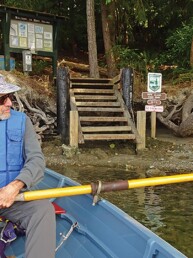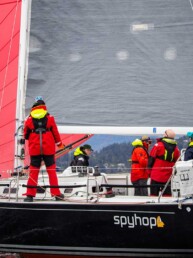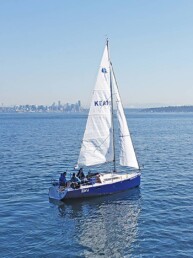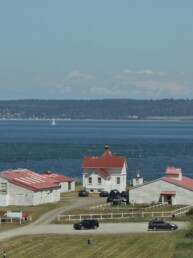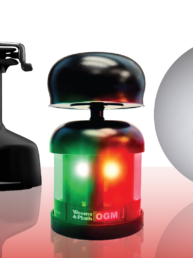As boaters, we care deeply about the special place that we call home. But how healthy are the waters of the Salish Sea that we cherish so much?
The U.S. Environmental Protection Agency and Environment and Climate Change Canada recently released their joint “The Health of the Salish Sea Report” analyzing 10 indicators of the health of the Salish Sea, the shared estuary that includes the Strait of Juan De Fuca, Puget Sound, and Georgia Basin.
The agencies also announced a new four-year “Action Plan” as the U.S. and Canada renew their Joint Statement of Cooperation – first signed in 2000 – which commits both countries to work to achieve shared goals for the Salish Sea ecosystem.
To describe the health of the Salish Sea ecosystem, the indicators focus on the following questions:
- What’s happening in the Salish Sea?
- Why is it important?
- Why is it happening?
- What’s being done about it?
The “Health of the Salish Sea Report” draws from publicly available monitoring, research, and other information to answer these questions for the time period of 2017 through 2020:
- Air Quality (Fine Particulates) – Neutral
Air quality has been generally improving over time due to new regulatory actions that control sources of air pollution in Washington and British Columbia. The increasing severity of summer wildfires with widespread and persistent smoke events threatens to offset the beneficial impacts of those air pollution control actions.
- Marine Species at Risk – Declining
Between 2011 and 2015, 17 new marine species were designated as either at-risk or candidates for a threatened or endangered status assessment. During this same time, 14 marine species previously designated as at-risk or candidates for a status assessment were determined to be no longer at-risk. Despite these improvements, the total number of marine species at risk doubled from 2002 to 2015.
- Chinook Salmon – Declining
Chinook salmon are the primary food source of the endangered Southern Resident Killer Whales. Salish Sea Chinook salmon populations are down 60 percent since the Pacific Salmon Commission began tracking salmon abundance in 1984. Between 2000 and 2018, the total number of Chinook returning to the Salish Sea has shown a relatively stable trend. However, over the last few reporting years, there has been a modest increase in catch and a modest decrease in fish returning to spawn.
- Southern Resident Killer Whales – Declining
Since 2006, the population has generally declined and has not shown signs of recovery, with only 74 individuals counted as of December 2020. This trend indicates that this population is facing increasing threats to its recovery and even survival.
- Toxics in the Food Web – Neutral
Concentrations of harmful legacy metals and persistent organic pollutants such as PCBs and PBDEs have been decreasing in fish and wildlife over time in many locations. However, their persistence in some habitats and species, such as English Sole and the Southern Resident Killer Whales, remains a cause for concern. Plastics, especially microplastics, are an emerging threat due to their prevalence, persistence, and ability to transport and release other pollutants. Emerging contaminants require further study to understand impacts within the Salish Sea ecosystem.
- Freshwater Quality – Neutral
Of the 20 rivers assessed since 2010, two showed decreasing water quality. In particular, the Fraser River score declined from “Good” to “Fair/Marginal.” Though another 10 of the rivers occasionally exceeded water quality guidelines, improving water quality scores were observed in three rivers (Cedar, Elwha, and Snohomish).
- Marine Water Quality – Declining
Marine dissolved oxygen levels continued to display a declining trend in the waters of Puget Sound and the Strait of Georgia from 2010 to 2019. Marine Water Condition Index scores have also been in general decline over the past 10 years for many areas. Increased nutrient loads are impacting water quality and habitats in many inlets and bays where forage fish and juvenile salmon spawn and rear, and where adult salmon gather before moving into watersheds to spawn.
- Stream Flow – Declining
Changes in stream flow can impact both human uses and the life cycles of salmon and other aquatic life. Since 1975, eight of the 17 rivers monitored and studied by programs in both countries showed significant decreasing summer flow trends. Another eight of the remaining nine rivers showed only minor increases or decreases in flow, with only one gaining flow and likely due to increasing snowmelt from a warming climate.
- Shellfish Harvesting – Improving
Despite increasing population growth and urbanization across the region, between 2007 and 2019 over 6,400 acres of previously closed shellfish beds in Puget Sound have been upgraded or re-opened for harvesting due to improvements in water quality. However, in the Georgia Basin between 2007 and 2019, there was an increase in closed shellfish beds.
- Swimming Beaches – Neutral
Between 2004 and 2018, nearly three-quarters of all swimming beaches consistently met water quality guidelines over each season. Other than shorter intervals following local heavy rain events, these beaches were almost always available for public use during that period.
“This report highlights the importance of continued partnership between the U.S. and Canada to nurture our shared Salish Sea,” said Michelle Pirzadeh, Acting regional administrator for EPA’s Region 10 office in Seattle. “These waters are the lifeblood of the millions who live in the communities of the region, and we’re confident that the partnerships and information sharing will produce positive results for our environment in the coming years and decades.”
The data in the report was provided by the Puget Sound Partnership, Fisheries and Oceans Canada, U.S. National Oceanic and Atmospheric Administration, Puget Sound Tribes and First Nations representing the Coast Salish Gathering , Washington State agencies, British Columbia agencies, Metro Vancouver, Western Washington University’s Salish Sea Institute, the SeaDoc Society, and many others.
In renewing the Statement of Cooperation and developing a new “Action Plan” for the next four years, the two agencies/nations committed to:
- Support for the Salish Sea Ecosystem Conference.
- Maintaining and further developing the transboundary Salish Sea ecosystem health indicators.
- Supporting information sharing activities on environmental and impact assessment and notification processes for projects in the Salish Sea ecosystem.
- Supporting Tribal-First Nation transboundary coordination and information sharing mechanisms.
- Supporting State/Provincial and local transboundary coordination and information sharing mechanisms.
- Promote and foster collaboration and information sharing activities on Salish Sea-related federal initiatives; identify opportunities where U.S. and Canadian federal interests and mechanisms may intersect.
In addition to the transboundary Salish Sea efforts noted above, the U.S. government funds a number of programs that contribute to the protection and recovery of Puget Sound, including EPA’s Puget Sound National Estuary Program which is led by the Puget Sound Partnership, and works in close coordination with other state and local agencies, Puget Sound Tribes, and many other local partners to further these needed recovery efforts. More information about this effort can be found in EPA’s recent report, the Puget Sound Geographic Program Funding at Work.
In support of these coordination efforts to help protect the shared Salish Sea ecosystem, thirteen U.S. federal departments agreed to form the Puget Sound Federal Task Force to coordinate and align programs and resources for Puget Sound Recovery at the federal level and created the first five-year action plan with over 100 actions supporting science and ecosystem recovery.
In 2016, Canada invested in enhanced protection of the Georgia Basin and the Strait of Juan de Fuca along with its other coasts through the Oceans Protection Plan. The OPP brings together four federal government ministries, Pacific North Coast First Nations, and other levels of government and stakeholders, to address several goals, including preserving and restoring marine ecosystems.
Local, on-the-ground, efforts by individuals, community groups, non-profits, First Nation organizations, tribal governments, counties, cities, municipalities, educational organizations, and many others, are all delivering forms of protection and restoration work that are showing results. Important examples of this work can be found at:
- Puget Sound Info, an interactive atlas of Puget Sound recovery activities hosted by the Puget Sound Partnership
- Environment and Climate Change Canada’s EcoAction Community Funding Program
- Fisheries and Oceans Canada’s Coastal Restoration Fund
- U.S. Environmental Protection Agency and Environment’s Puget Sound Geographic Program Funding at Work
Editor
48° North Editors are committed to telling the best stories from the world of Pacific Northwest boating. We live and breathe this stuff, and share your passion for the boat life. Feel free to keep in touch with tips, stories, photos, and feedback at news@48north.com.
